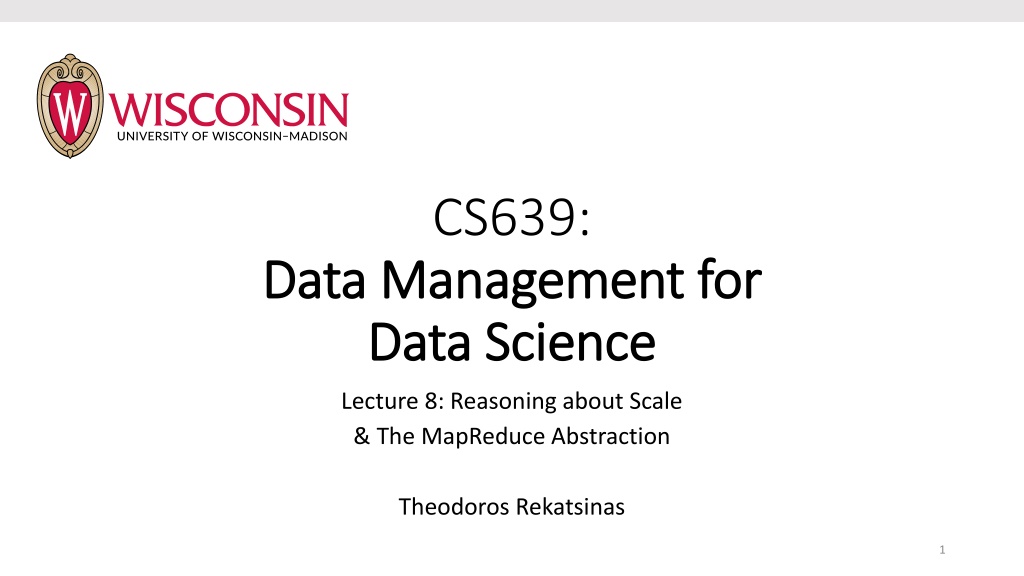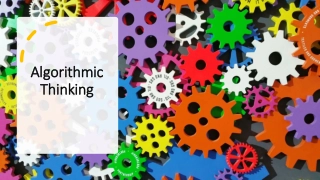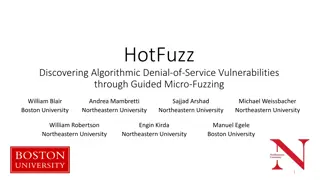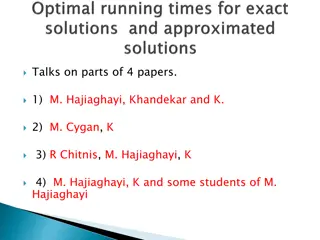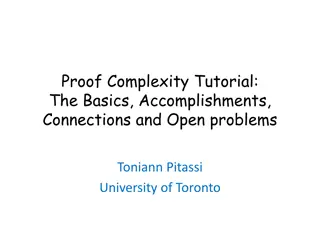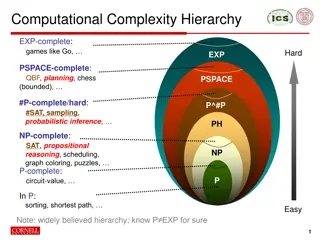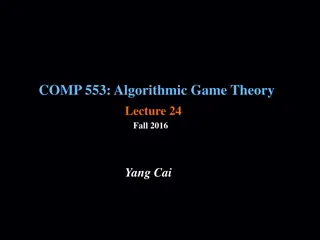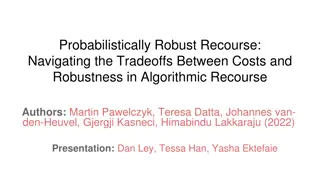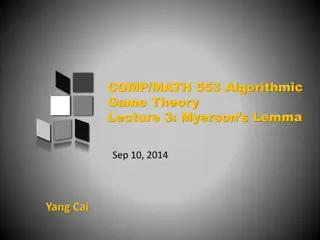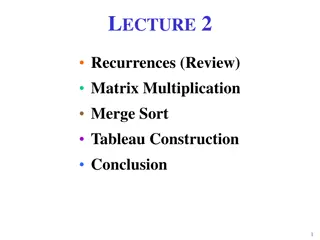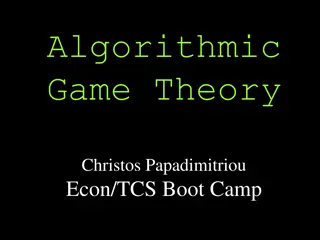Understanding Scalability and Algorithmic Complexity in Data Management for Data Science
This lecture delves into the concept of scalability in data management for data science, covering operational and algorithmic aspects. It discusses the importance of efficient resource utilization, scaling out to multiple computing nodes, and managing algorithmic complexity for optimal performance in handling large datasets.
Download Presentation

Please find below an Image/Link to download the presentation.
The content on the website is provided AS IS for your information and personal use only. It may not be sold, licensed, or shared on other websites without obtaining consent from the author. Download presentation by click this link. If you encounter any issues during the download, it is possible that the publisher has removed the file from their server.
E N D
Presentation Transcript
CS639: Data Management for Data Management for Data Science Data Science Lecture 8: Reasoning about Scale & The MapReduce Abstraction Theodoros Rekatsinas 1
Logistics/Announcements Submission template for PA2 Bonus problem for PA2 Other questions on PA2? 2
Todays Lecture 1. Scalability and Algorithmic Complexity 2. Data-Parallel Algorithms 3. The MapReduce Abstraction 3
1. Scalability and Algorithmic Complexity 4
What does scalable mean? Operationally: Works even if the data does not fit in main memory Use all available resources (cores/memory) on a single node (aka scale up) Can make use of 1000s of cheap computers (cloud) elastic (aka scale out) Algorithmically: If you have N data items you should not perform more than Nm operations (polynomial complexity) In many cases it should be N*log(N) operations (streaming or too large data) If you have N data items, you must do no more than Nm/koperations for some large k (k = number of cores/threads)
A sketch of algorithmic complexity Example: Find matching string sequences Given a set of string sequences Find all sequences equal to GATTACGA
Example: Find matching string sequences GATTACGA TACCTGCC Time = 0: TACCTGCC ? GATTACGA
Example: Find matching string sequences GATTACGA TACCTGCC Time = 0: TACCTGCC ? GATTACGA No move cursor to next data entry
Example: Find matching string sequences GATTACGA EFTAAGCA Time = 1: EFTAAGCA ? GATTACGA No move cursor to next data entry
Example: Find matching string sequences GATTACGA Time = 2: XXXXXXX ? GATTACGA No move cursor to next data entry
Example: Find matching string sequences GATTACGA Time = n: GATTACGA ? GATTACGA Yes! Output matching sequence
Example: Find matching string sequences GATTACGA If we have 40 records we need to perform 40 comparisons
Example: Find matching string sequences GATTACGA For N records we perform N comparisons The algorithmic complexity is order N: O(N)
What if we knew the sequences are sorted sorted Increasing Lexicographic Order GATTACGA
What if we knew the sequences are sorted sorted Increasing Lexicographic Order GATTACGA Time = 0: Start at 50% mark CTGTACA < GATTACGA
What if we knew the sequences are sorted sorted Increasing Lexicographic Order GATTACGA Time = 1: Start at 50% mark CTGTACA < GATTACGA Skip to 75% mark (you know your sequence is in the second half)
What if we knew the sequences are sorted sorted Increasing Lexicographic Order GATTACGA Time = 2: We are at the 75% mark TTGTCCA > GATTACGA Skip to 62.5% mark Match: GATTACGA = GATTACGA We find our sequence in three steps. Now we can scan entries sequentially.
What if we knew the sequences are sorted sorted Increasing Lexicographic Order GATTACGA How many comparisons? For N records we did log(N) comparisons The algorithm has complexity O(log(N)) much better scalability
New task: Trim string sequences Given a set of string sequences Trim the final n characters of each sequence Generate a new dataset
New task: Trim string sequences (last 3 chars) TACCTGCC Time = 0: TACCTGCC -> TACCTG
New task: Trim string sequences (last 3 chars) GATTCTGC Time = 1: GATTCTGC -> GATTC
New task: Trim string sequences (last 3 chars) CCCGAAT Time = 2: CCCGAAT -> CCCG Can we use a data structure to speed this operation?
New task: Trim string sequences (last 3 chars) CCCGAAT Time = 2: CCCGAAT -> CCCG Can we use a data structure to speed this operation? No. We have to touch every record! The task is O(N).
New task: Trim string sequences (last 3 chars) Time = 1: Process first element of each group
New task: Trim string sequences (last 3 chars) Time = 2: Process second element of each group
New task: Trim string sequences (last 3 chars) Time = 3: Process third element of each group Etc.. How much time does this take?
New task: Trim string sequences (last 3 chars) We only need O(N/k) operations where k is the number of groups (workers)
Schematic of Parallel Algorithms 1. You are given a set of reads . You have to process them and generate a write 2. You distribute the reads among k computers (workers)
2. You distribute the reads among k computers (workers) Schematic of Parallel Algorithms 3. Apply function f to each read (for every item in each chunk) Function f Function f Function f Function f 4. Obtain a big distributed set of outputs
Applications of parallel algorithms Convert TIFF images to PNG Run thousands of simulations for different model parameters Find the most common word in each document Compute the word frequency of every word in a single document Etc .
Applications of parallel algorithms Convert TIFF images to PNG Run thousands of simulations for different model parameters Find the most common word in each document Compute the word frequency of every word in a single document Etc . There is a common pattern in all these applications
Applications of parallel algorithms A function that maps a string to a trimmed string A function that maps a TIFF images to a PNG image A function that maps a set of parameters to simulation results A function that maps a document to its most common word A function that maps a document to a histogram of word frequencies
Applications of parallel algorithms What if we want to compute the word frequency across all documents?
Compute the word frequency across documents across 5M
Compute the word frequency across documents across 5M
Challenge: in this task How can we make sure that a single computer has access to every occurrence of a given word regardless of which document it appeared in? Ideas?
Compute the word frequency across across 5M documents
Compute the word frequency across across 5M documents
Compute the word frequency across across 5M documents
Compute the word frequency across across 5M documents A hash function is any function that can be used to map data of arbitrary size to a data of a fixed size
Compute the word frequency across across 5M documents
The Map Reduce Abstraction for Distributed Algorithms Distributed Data Storage Map (Shuffle) Reduce
